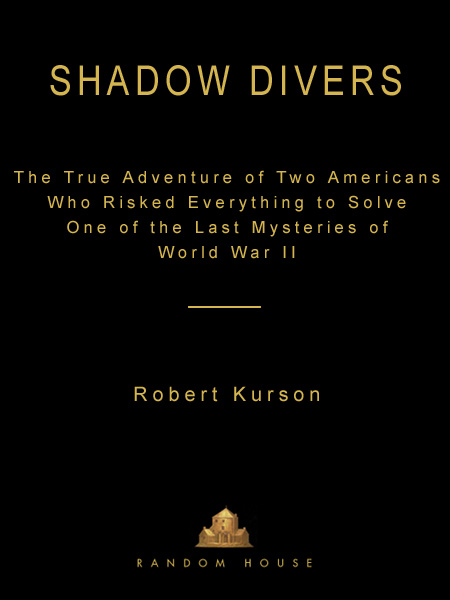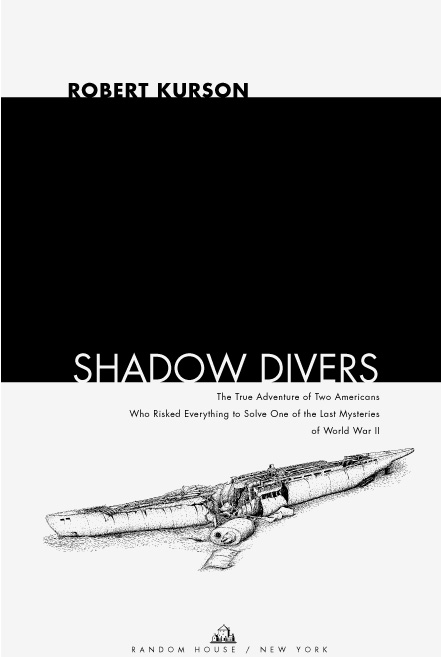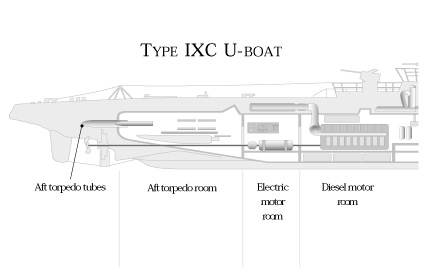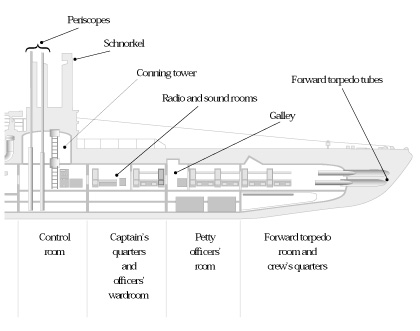Shadow Divers



CONTENTS
Chapter one THE BOOK OF NUMBERS
Chapter three A SHAPE OF POWER
Chapter seven HORENBURG’S KNIFE
Chapter eight NOTHING AT THAT LOCATION
Chapter eleven A MISSED SIGNAL
Chapter twelve NONE OF US IS COMING BACK
Chapter thirteen THE U-BOAT IS OUR MOMENT
Chapter fourteen CIRCLE-RUNNER
F
OR
A
MY,
the answer to my life’s search
F
OR
N
ATE
, already a seeker
Life’s splendor forever lies in wait about each one of us in all its fullness, but veiled from view, deep down, invisible, far off. It is there, though, not hostile, not reluctant, not deaf. If you summon it by the right word, by its right name, it will come.
—Franz Kafka,
Diaries
AUTHOR’S NOTE
A few years ago, a friend told me a remarkable story. Two recreational scuba divers had recently discovered a World War II German U-boat off the New Jersey coast. The fifty-six-man crew was still aboard. No government, expert, historian, or navy had a clue as to which submarine it was, who the sailors were, or why it was in New Jersey.
My first reaction was that the story sounded too amazing to be true. Still, it awakened childhood memories in me. For years, my grade school classes had taken field trips to Chicago’s Museum of Science and Industry to see its two centerpiece exhibits: a working coal mine and
U-505,
a German U-boat captured in 1944. Most kids preferred the coal mine, which featured moving cars and live explosions. I was drawn to the submarine. This eel-shaped fighting machine, with its furious interior of pipes and wire and gauges and weapons, seemed more terrifying than any bomber plane or Sherman tank. Seeing it resting there, just yards from the banks of Lake Michigan, I imagined this invisible hunter stalking the shoreline where I swam. This U-boat, I thought, could have come to within a mile or two of my house.
I called John Chatterton and Richie Kohler, the two New Jersey divers, and asked if I might fly out to hear their story. We met at Chatterton’s house, where he had parked his vintage Royal Enfield motorcycle next to Kohler’s late-model Harley. Chatterton was a commercial diver who did underwater construction jobs around Manhattan. Kohler owned a glass-repair business. They dove for shipwrecks on weekends. Each seemed, in every respect, a regular guy.
I promised not to take much of their time. Fourteen hours later, I was still listening. They told of discovering not just a U-boat but mystery, adventure, high-seas rivalries and bitter feuds, and membership in an obsessed culture of immensely brave men. They also told me of an intellectual odyssey, one in which they had made themselves into expert researchers, pored over original documents, learned bits of German, hunted clues abroad, constructed original theories, challenged professional historians, and ultimately rewritten a page of history long presumed to be gospel.
“Sounds like a novel, huh?” Kohler said to me in his thick Brooklyn accent as he fired up his Harley. Driving to the airport that night, I could scarcely believe my luck. In Chatterton and Kohler, I had found two ordinary men who had confronted an extraordinarily dangerous world and solved a historical mystery that even governments had not been able to budge. Any one of the elements of their story raised intriguing possibilities. Taken together, they made for a once-in-a-lifetime writing opportunity. I could no more turn my back on a chance to write the divers’ story than they could have turned their backs on the chance to identify the mystery U-boat. In that sense, Chatterton, Kohler, and I already had something in common.
So this is their story. All of it is true and accurate. Nothing is imagined or interpreted, and no literary liberties have been taken. The book is rooted in hundreds of hours of interviews with Chatterton and Kohler, plus countless more hours with divers, historians, experts, relatives, and other witnesses to the events described herein. Dialogue—even that from World War II—is taken directly from interviews I conducted with people who were there and witnessed the events. Everything was checked against multiple sources whenever possible.
While researching the dangers of deep-shipwreck diving, I was struck by a remark the divers made about depth. The mystery U-boat, they said, lay in such deep, dark waters that occasionally they could do little more than dive at shadows. It occurred to me then that there were shadows cast throughout the story—by the fallen crewmen, by World War II, by the seeming infallibility of written history, by questions the divers came to ask about themselves as men. For six years, Chatterton and Kohler were shadow divers. For six years, they went on a remarkable journey. I wrote this book to take you there with them.


CHAPTER ONE
THE BOOK OF NUMBERS
Brielle, New Jersey, September 1991
B
ILL
N
AGLE’S LIFE CHANGED
the day a fisherman sat beside him in a ramshackle bar and told him about a mystery he had found lying at the bottom of the Atlantic Ocean. Against his better judgment, that fisherman promised to tell Nagle how to find it. The men agreed to meet the next day on the rickety wooden pier that led to Nagle’s boat, the
Seeker,
a vessel Nagle had built to chase possibility. But when the appointed time came, the fisherman was not there. Nagle paced back and forth, careful not to plunge through the pier where its wooden planks had rotted away. He had lived much of his life on the Atlantic, and he knew when worlds were about to shift. Usually, that happened before a storm or when a man’s boat broke. Today, however, he knew it was going to happen when the fisherman handed him a scrap of paper, a hand-scrawled set of numbers that would lead to the sunken mystery. Nagle looked into the distance for the fisherman. He saw no one. The salt air blew against the small seashore town of Brielle, tilting the dockside boats and spraying the Atlantic into Nagle’s eyes. When the mist died down he looked again. This time, he saw the fisherman approaching, a small square of paper crumpled in his hands. The fisherman looked worried. Like Nagle, he had lived on the ocean, and he also knew when a man’s life was about to change.
In the whispers of approaching autumn, Brielle’s rouge is blown away and what remains is the real Brielle, the locals’ Brielle. This small seashore town on the central New Jersey coast is the place where the boat captains and fishermen live, where convenience store owners stay open to serve neighbors, where fifth graders can repair scallop dredges. This is where the hangers-on and wannabes and also-rans and once-greats keep believing in the sea. In Brielle, when the customers leave, the town’s lines show, and they are the kind grooved by the thin difference between making a living on the water and washing out.
The
Seeker
towers above the other boats tied to this Brielle dock, and it’s not just the vessel’s sixty-five-foot length that grabs one’s attention, it’s the feeling—from her battered wooden hull and nicked propellers—that she’s been places. Conceived in Nagle’s imagination, the
Seeker
was built for a single purpose: to take scuba divers to the most dangerous shipwrecks in the Atlantic Ocean.
Nagle was forty years old then, a thin, deeply tanned former Snap-On Tools Salesman of the Year. To see him here, waiting for this fisherman in his tattered T-shirt and thrift-shop sandals, the Jim Beam he kept as best friend slurring his motions, no one would guess that he had been an artist, that in his day Nagle had been great.
In his twenties, Nagle was already legend in shipwreck diving, a boy wonder in a sport that regularly kills its young. In those days, deep-wreck diving was still the province of the adventurer. Countless shipwrecks, even famous ones, lay undiscovered at the bottom of the Atlantic, and the hunt for those wrecks—with their bent metal and arrested history—was the motion that primed Nagle’s imagination.
Treasure never figured into the equation for Atlantic shipwreck divers in the Northeast. Spanish galleons overflowing with gold doubloons and silver pieces of eight did not sink in this part of the ocean, and even if they had, Nagle wouldn’t have been interested. His neighborhood was the New York and New Jersey shipping lanes, waters that conducted freighters, ocean liners, passenger vessels, and warships about the business and survival of America. These wrecks occasionally surrendered a rare piece of china or jewelry, but Nagle and his kind were looking for something different. They saw stories in the Modiglianied faces of broken ships, frozen moments in a nation’s hopes or a captain’s dying instinct or a child’s potential, and they experienced these scenes unbuffered by curators or commentators or historians, shoulder to shoulder with life as it existed at the moment it had most mattered.
And they did it to explore. Many of the deep wrecks hadn’t been seen since their victims last looked at them, and would remain lost while nature pawed at them until they simply didn’t exist anymore. In a world where even the moon had been traveled, the floor of the Atlantic remained uncharted wilderness, its shipwrecks beacons for men compelled to look.
You had to have steel balls to do what Nagle did in his heyday. In the 1970s and 1980s, scuba equipment was still rudimentary, not much advanced past 1943, when Jacques Cousteau helped invent the system of tanks and regulators that allowed men to breathe underwater. Even at 130 feet, the recreational limit suggested by most scuba training organizations, a minor equipment failure could kill the most skilled practitioner. In searching for the most interesting wrecks, Nagle and the sport’s other kings might descend to 200 feet or deeper, virtually begging the forces of nature to flick them into the afterlife, practically demanding their biology to abandon them. Men died—often—diving the shipwrecks that called to Nagle.
Even if Nagle’s equipment and body could survive the deep Atlantic, he faced a smorgasbord of other perils, each capable of killing him à la carte. For starters, the sport was still new; there was no ancient wisdom to be passed from father to son, the kind of collective experience that routinely keeps today’s divers alive. The sport’s cautionary tales, those lifelines learned over beers with buddies and by reading magazines and attending classes, were beaten into Nagle underwater at antihuman depths. If Nagle found himself in some crazy, terrible circumstance—and there were countless of them on these deep wrecks—odds were that he would be the one who would tell the first tale. When he and his ilk survived, the magazines wrote articles about them.
Nagle pushed deeper. Diving below 200 feet, he began doing things scientists didn’t fully understand, going places recreational divers had never been. When he penetrated a shipwreck at these depths, he was often among the first to see the vessel since it had gone down, the first to open the purser’s safe since it had been closed, the first to look at these men since they had been lost at sea. But this also meant that Nagle was on his own. He had no maps drawn by earlier divers. Had someone visited these wrecks before, he might have told Nagle, “Don’t brush against that outboard beam in the galley—the thing moved when I swam by, and the whole room might cave in and bury you if you do.” Nagle had to discover all this by himself. It is one thing, wreck divers will tell you, to slither in near-total darkness through a shipwreck’s twisted, broken mazes, each room a potential trap of swirling silt and collapsing structure. It is another to do so without knowing that someone did it before you and lived.
The Atlantic floor was still a wilderness in Nagle’s prime, and it demanded of its explorers the same grit that the American West did of its pioneers. A single bad experience on a shipwreck could reroute all but the hardiest souls to more sensible pursuits. Early divers like Nagle had bad experiences every day. The sport eagerly shook out its dabblers and sightseers; those who remained seemed of a different species. They were physical in their world orientation and sudden in their appetites. They thought nothing of whipping out a sledgehammer and beating a porthole from the side of a ship, even as their heavy breath hastened nitrogen narcosis, the potentially deadly buildup of that otherwise benign gas in their brains. Underwater, rules of possession bent with the light; some divers cut prizes from the mesh goody bags of other divers, following the motto “He who floats it owns it.” Fistfights—aboard boats and even underwater—often settled disputes. Artifacts recovered from wrecks were guarded like firstborn children, occasionally at knifepoint. In this way, early deep-wreck divers had a measure of pirate in their blood.
But not Nagle. In the sport’s brawniest era, he was a man of the mind. He devoured academic texts, reference works, novels, blueprints, any material he could uncover on historical ships, until he could have stood in the dockyards of a dozen eras and built the boats alongside the workers. He was a connoisseur of the parts, and he reveled in the life force a boat took on from the interlocking of its pieces. This insight gave Nagle two-way vision; as much as he understood the birth of a ship, he also understood its death. Ordinary divers would come upon a shipwreck and see the mélange of bent steel and broken wood, the shock of pipe and wire as a cacophony of crap, an impediment that might be hiding a compass or some other prize. They would plant their noses in a random spot and dig like puppies, hoping to find a morsel. Viewing the same scene, Nagle repaired the broken parts in his mind and saw the ship in its glory. One of his greatest finds was a four-foot-tall brass whistle from the paddle wheeler
Champion,
a proud voice that had been mounted on the ship’s mast and powered by a steam line. The whistle was majestic, but the most beautiful part of the discovery was that underwater it looked like a worthless pipe. Floating amid the wreckage, Nagle used his mind’s eye to watch the ship break and sink. He knew the ship’s anatomy, and as he imagined it coming apart he could see the whistle settle, right where that seemingly worthless piece of pipe lay. After Nagle recovered two helms from the British tanker
Coimbra
in a single day (finding one helm once in a career was rare enough), his photograph was hung—alongside that of Lloyd Bridges—in the wheelhouse of the
Sea Hunter,
a leading dive charter boat of the time. He was twenty-five.
To Nagle, the value in artifacts like the brass steam whistle lay not in their aesthetics or their monetary worth but in their symbolism. It is an odd sight to see grown men covet teacups and saucers, and build noble display cases to these dainty relics. But to divers like Nagle these trinkets represented exploration, going off the charts. A telegraph on display in a diver’s living room, therefore, is much more than a shiny object; it is an announcement. It says,
If someone had been to this ship’s wheelhouse before me, he would not have left this telegraph behind.
It was only time before Nagle’s instinct delivered him to the
Andrea Doria,
the Mount Everest of shipwrecks. The grand Italian passenger liner had collided with the
Stockholm,
a Swedish liner, in dense fog off Nantucket Island in 1956. Fifty-one people died; 1,659 were rescued before the liner sank and settled on her side at a depth of 250 feet. The
Doria
was not a typical target for Nagle. Her location was widely known, and she had been explored by divers since the day after her sinking. But the
Doria
made siren calls to great wreck divers. She was brimming with artifacts even after all these years: serving sets made of fine Italian china and painted with the ship’s legendary Italia logo, silver utensils, luggage, ceramic tiles by famed artists, pewter sherbet dishes, jewelry, signs. In Nagle’s day, and even today, a diver could explore the
Doria
and worry only about having enough stamina to lug home the prizes he recovered.
Had the
Doria
only her riches to offer, she could not have romanced Nagle so hopelessly. The ship’s real challenge lay in exploration. The wreck rested on its side, making navigation dangerous and deceptive. A diver had to conceive the world sideways to make sense of doors on the floor and ceilings to the right. And she was deep—180 feet at her shallowest and 250 feet where she crushed the ocean floor. Men sometimes got disoriented or ran out of air or lost their minds from narcosis and died on the
Doria.
The wreck was so deep, dark, and dangerous that decades after her sinking, entire decks remained unexplored. Those decks were Nagle’s destinations.
Over time, Nagle penetrated the wreck in places long relegated to the impossible. His mantel at home became a miniature
Doria
museum. Soon, he set his sights on the bell. A ship’s bell is her crown, her voice. For a diver, there is no greater prize, and many of the greats go a career without coming close to recovering one. Nagle decided to own the
Doria
’s bell. People thought he was nuts—scores of divers had searched for thirty years for the
Doria
’s bell. No one believed it was there.
Nagle went to work. He studied deck plans, books of photographs, crew diaries. Then he did what few other divers did: he formulated a plan. He would need days, maybe even a week to pull it off. No charter boat, however, was going to take a diver to the
Doria
for a week. So Nagle, who had saved a good bit of money from his Snap-On Tools days, decided to buy a dive boat himself, a vessel constructed from his imagination for a single purpose: to salvage the
Doria
’s bell.
That boat was the original
Seeker,
a thirty-five-foot Maine Coaster built in New Jersey by Henrique. In 1985, Nagle recruited five top divers, men who shared his passion for exploration, and he made this arrangement: He would take the group to the
Doria
at his expense. The trip would be a dedicated one, meaning the divers went with just one objective—to recover the bell.
For the first few days on the wreck, the divers stuck to Nagle’s plan. They found nothing. The bell just wasn’t there. At that point, even the hardiest divers would have turned back. A single day on the open Atlantic in a sixty-five-foot boat will turn intestines inside out; Nagle and his cohorts had been out for four days in a thirty-five-foot glorified bathtub. But a man is not so inclined to give up when he sees in panoramas. Nagle abandoned the bow of the
Doria,
where he and his team had been searching, and rerouted to the stern. They would now be flying by the seat of their pants, an improvisation on the deadliest wreck in the Atlantic. No one had ever been to the stern. Yet by conceiving the
Doria
as a single, breathing organism rather than as detached, twenty-foot chunks of wood and steel, Nagle and the others allowed themselves to look in unlikely places.
On the fifth day they hit pay dirt—there was the
Andrea Doria
’s bell. The men rigged it, beat out the bell’s pin with a sledgehammer, and sent up the prize on a heavy-duty lift bag. Shock waves rippled through the diving community. According to their agreement, Nagle owned half the bell, and the other five men owned half; the last man living among them would own it outright. Nagle placed the 150-pound bell into the back of his wife’s station wagon and asked her to drive it home. When she arrived, the bell wasn’t there anymore. She called Nagle, saying, “I don’t know what happened to the bell!” Nagle nearly suffered a heart attack. He called the highway patrol and asked, “Did anyone find a giant bell anywhere?” Someone had, in fact, made a report, telling the police something like “I found something and I don’t know what it is, but it looks like a big bell and it says
Andrea Doria.
” Nagle almost had another attack. He retrieved the bell and insured it for $100,000. He was among the immortals.
